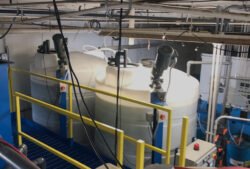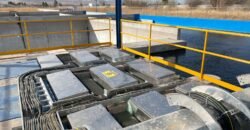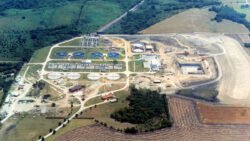
Greater Lawrence Sanitary District Wastewater Treatment Plant

The Greater Lawrence Sanitary District (GLSD) Wastewater Treatment Plant is a cornerstone of environmental management and public health for the Merrimack Valley region in Massachusetts. Since its inception, the GLSD has served as a model of efficiency and innovation in wastewater treatment, adapting to meet the changing needs of the population it serves and the evolving standards of environmental protection.
Population Served and Geographic Scope
The GLSD Wastewater Treatment Plant serves approximately 250,000 residents in several communities, including Lawrence, Methuen, Andover, North Andover, and a portion of Dracut in Massachusetts, as well as the towns of Salem and Plaistow in New Hampshire. This broad service area encompasses both densely populated urban centers and quieter suburban neighborhoods, requiring the plant to manage a complex web of wastewater inputs.
Wastewater Volume and Treatment Capacity
On average, the GLSD processes around 40 million gallons of wastewater daily, but it’s built to handle much more, with a treatment capacity of up to 52 million gallons per day. This scalability ensures that the plant can accommodate fluctuations in wastewater volume due to seasonal variations, extreme weather events, and future population growth.
Advanced Treatment Processes
The treatment processes at GLSD are designed to remove contaminants and produce effluent that meets stringent environmental standards. The facility uses a combination of primary, secondary, and tertiary treatment methods. Initially, the wastewater undergoes screening and grit removal to eliminate large debris and grit. This step is crucial for protecting downstream equipment from wear and damage.
Next, the primary treatment process involves sedimentation tanks where solids settle to the bottom and oils and grease float to the surface for removal. The secondary treatment phase employs biological aeration tanks, where microorganisms digest organic pollutants. Finally, the tertiary treatment includes sand filtration and disinfection, typically using chlorine or UV light, to ensure that the effluent released into the Merrimack River is safe.
Recent Upgrades and Technological Innovations
Recent years have seen significant technological upgrades and expansions at the GLSD Wastewater Treatment Plant. In 2020, the plant completed a $62 million upgrade project to enhance its nutrient removal capabilities, specifically targeting nitrogen and phosphorus. Excess nitrogen and phosphorus can cause harmful algal blooms and dead zones in water bodies, making advanced nutrient removal crucial for maintaining healthy aquatic ecosystems.
The installation of advanced biological nutrient removal (BNR) systems allows the plant to meet stringent discharge limits set by the Environmental Protection Agency (EPA). The BNR process involves tailoring the aeration and anoxic conditions within the bioreactors to encourage microbial activity that effectively removes nitrogen and phosphorus.
Moreover, GLSD has invested in renewable energy projects, including a combined heat and power (CHP) system that uses biogas produced from anaerobic digestion to generate electricity and heat. This not only reduces the plant’s carbon footprint but also lowers operational costs, savings which can be passed on to the community.
Recent Local News and Developments
In recent news, the GLSD has been in the spotlight for its proactive approach to addressing the challenges posed by climate change. With increasing instances of extreme weather events, the plant has undertaken a resilience assessment to identify vulnerabilities in its infrastructure and operations.
The assessment, conducted in collaboration with local universities and environmental consultancies, has led to a series of recommendations that the GLSD is beginning to implement. These include floodproofing essential electrical systems, enhancing the capacity of stormwater management systems, and revising operational protocols to ensure uninterrupted service during extreme weather events.
Additionally, in September 2023, the GLSD announced a strategic partnership with the Massachusetts Department of Environmental Protection (MassDEP) to pilot innovative green infrastructure projects aimed at reducing stormwater runoff. These projects include the construction of permeable pavements, bioswales, and green roofs in urban areas.
Highlighting Key Projects
1. CSO (Combined Sewer Overflow) Reduction Program
One of the major ongoing projects is the CSO Reduction Program. Combined sewer systems, which carry both stormwater and sanitary sewage in a single pipe, can overflow during heavy rain, discharging untreated wastewater directly into water bodies. The GLSD has committed to a multi-million dollar project focused on separating these systems to mitigate the risk of overflows.
2. PFAS Treatment Implementation
Per- and polyfluoroalkyl substances (PFAS) are a group of man-made chemicals that have raised significant health concerns. The GLSD is at the forefront of addressing this issue, working with state and federal agencies to pilot PFAS removal technologies. These efforts include granular activated carbon (GAC) filters and ion exchange systems to treat PFAS-contaminated water.
3. Community Engagement Initiatives
The GLSD understands the importance of community involvement and transparency. To this end, it has launched several community engagement initiatives to educate the public about wastewater treatment and its environmental impacts. One notable initiative is the annual “Open House and Facility Tour,” where residents can learn about the treatment processes and see the operations first-hand.
4. Educational Outreach Programs
The GLSD partners with local schools and universities to offer educational programs about environmental science and engineering. These programs include site visits, guest lectures, and internships, providing students with practical knowledge and experience in various aspects of wastewater management.
Community Involvement and Public Awareness
Engagement with the community is a pillar of the GLSD’s mission. The district hosts regular public meetings and workshops to gather input on proposed projects and operational changes. These forums provide an opportunity for residents to voice concerns, ask questions, and offer feedback.
Furthermore, the GLSD actively collaborates with community organizations, environmental groups, and governmental agencies to promote sustainability and environmental stewardship within the region. This collaboration extends to public awareness campaigns, such as the “Keep Our Rivers Clean” initiative, which educates the public on the importance of proper waste disposal and the impact of pollutants on local waterways.
Challenges and Future Directions
While the GLSD has made significant strides in modernizing its facilities and operations, it faces ongoing challenges. The increasing occurrence of extreme weather due to climate change, aging infrastructure, and the need for continuous technological upgrades demand consistent attention and resources. Moreover, regulatory pressures and evolving water quality standards require the GLSD to remain adaptable and forward-thinking.
Looking ahead, the GLSD plans to explore additional renewable energy projects, such as solar photovoltaic installations, to further reduce its environmental footprint. Additionally, the district is investigating the feasibility of implementing advanced data analytics and machine learning technologies to optimize treatment processes and predictive maintenance practices.
Conclusion
The Greater Lawrence Sanitary District Wastewater Treatment Plant exemplifies a commitment to public health, environmental stewardship, and community engagement. Through its advanced treatment processes, ongoing projects, and proactive approach to future challenges, the GLSD continues to set a high standard for wastewater management. As the plant evolves to meet new demands, it ensures that the Merrimack Valley remains a safe and healthy place for its residents and the surrounding ecosystems.
This journey of progress and continuous improvement not only highlights the importance of wastewater treatment in preserving public health and the environment but also underscores the vital role that community collaboration and technological innovation play in achieving sustainable development.


